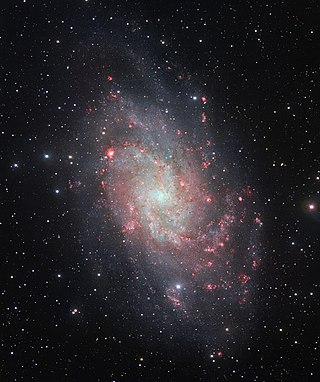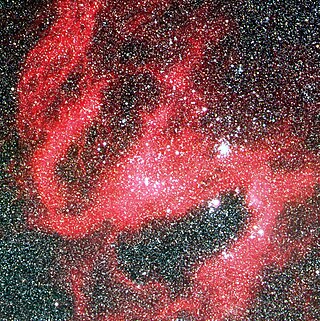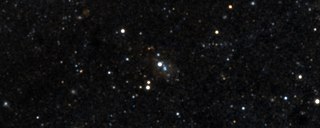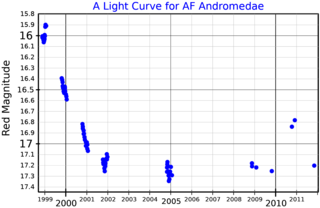
The Andromeda Galaxy is a barred spiral galaxy and is the nearest major galaxy to the Milky Way, where the Solar System resides. It was originally named the Andromeda Nebula and is cataloged as Messier 31, M31, and NGC 224. Andromeda has a diameter of about 46.56 kiloparsecs and is approximately 765 kpc from Earth. The galaxy's name stems from the area of Earth's sky in which it appears, the constellation of Andromeda, which itself is named after the princess who was the wife of Perseus in Greek mythology.

The Triangulum Galaxy is a spiral galaxy 2.73 million light-years (ly) from Earth in the constellation Triangulum. It is catalogued as Messier 33 or NGC (New General Catalogue) 598. With the D25 isophotal diameter of 18.74 kiloparsecs (61,100 light-years), the Triangulum Galaxy is the third-largest member of the Local Group of galaxies, behind the Andromeda Galaxy and the Milky Way.

The Pistol Star is an extremely luminous blue hypergiant star, one of the most luminous and massive known in the Milky Way. It is one of many massive young stars in the Quintuplet cluster in the Galactic Center region. The star owes its name to the shape of the Pistol Nebula, which it illuminates. It is located approximately 25,000 light-years from Earth in the direction of Sagittarius. The star has a large mass comparable to V4998 Sagittarii and a luminosity 3.3 million times that of the Sun (L☉). It would be visible to the naked eye as a 4th-magnitude star if it were not for the interstellar dust near the Center of the Milky Way that absorbs almost all of its visible light.

S Doradus is one of the brightest stars in the Large Magellanic Cloud (LMC), a satellite galaxy of the Milky Way, located roughly 160,000 light-years away. The star is a luminous blue variable, and one of the most luminous stars known, having a luminosity varying widely above and below 1,000,000 times the luminosity of the Sun, although it is too far away to be seen with the naked eye.

Luminous blue variables (LBVs) are massive evolved stars that show unpredictable and sometimes dramatic variations in their spectra and brightness. They are also known as S Doradus variables after S Doradus, one of the brightest stars of the Large Magellanic Cloud. They are extraordinarily rare, with just 20 objects listed in the General Catalogue of Variable Stars as SDor, and a number of these are no longer considered LBVs.

A yellow hypergiant (YHG) is a massive star with an extended atmosphere, a spectral class from A to K, and, starting with an initial mass of about 20–60 solar masses, has lost as much as half that mass. They are amongst the most visually luminous stars, with absolute magnitude (MV) around −9, but also one of the rarest, with just 20 known in the Milky Way and six of those in just a single cluster. They are sometimes referred to as cool hypergiants in comparison with O- and B-type stars, and sometimes as warm hypergiants in comparison with red supergiants.

AG Carinae is a star in the constellation Carina. It is classified as a luminous blue variable (LBV) and is one of the most luminous stars in the Milky Way. The great distance and intervening dust mean that the star is not usually visible to the naked eye; its apparent brightness varies erratically between magnitude 5.7 and 9.0.

R Andromedae is a Mira-type variable star in the constellation Andromeda. Its spectral class is type S because it shows absorption bands of zirconium monoxide (ZrO) in its spectrum. It was among the stars found by Paul Merrill to show absorption lines of the unstable element technetium, establishing that nucleosynthesis must be occurring in stars. The SH molecule was found for the first time outside earth in the atmosphere of this star. The star is losing mass due to stellar winds at a rate of 1.09×10−6M☉/yr.

HR Carinae is a luminous blue variable star located in the constellation Carina. It is surrounded by a vast nebula of ejected nuclear-processed material because this star has a multiple shell expanding atmosphere. This star is among the most luminous stars in the Milky Way. It has very broad emission wings on the Balmer lines, reminiscent from the broad lines observed in the spectra of O and Wolf–Rayet stars. A distance of 5 kpc and a bolometric magnitude of -9.4 put HR Car among the most luminous stars of the galaxy.

VY Canis Majoris is an extreme oxygen-rich (O-rich) red hypergiant (RHG) or red supergiant (RSG) and pulsating variable star 1.2 kiloparsecs from the Solar System in the slightly southern constellation of Canis Major. It is one of the largest known stars, one of the most luminous and massive red supergiants, and one of the most luminous stars in the Milky Way.

A hypergiant (luminosity class 0 or Ia+) is a very rare type of star that has an extremely high luminosity, mass, size and mass loss because of its extreme stellar winds. The term hypergiant is defined as luminosity class 0 (zero) in the MKK system. However, this is rarely seen in literature or in published spectral classifications, except for specific well-defined groups such as the yellow hypergiants, RSG (red supergiants), or blue B(e) supergiants with emission spectra. More commonly, hypergiants are classed as Ia-0 or Ia+, but red supergiants are rarely assigned these spectral classifications. Astronomers are interested in these stars because they relate to understanding stellar evolution, especially star formation, stability, and their expected demise as supernovae.

HD 5980 is a multiple star system on the outskirts of NGC 346 in the Small Magellanic Cloud (SMC) and is one of the brightest stars in the SMC.
VHK 83 is a luminous blue variable (LBV) in the constellation Triangulum, in the Triangulum Galaxy. With its bolometric luminosity of at least 2,240,000 times that of the Sun, it was described as "the brightest nonstable star in M33" and is one of the most luminous stars known.

V4998 Sagittarii is a luminous blue variable star (LBV) in the constellation of Sagittarius. Located some 25,000 light-years away, the star is positioned about 7 pc away from a starburst cluster known as the Quintuplet cluster. It has an ejection nebula measuring over 0.8 pc in diameter, formed 5000-10,000 years ago through large eruptions. The star has a large mass comparable to the Pistol Star and a luminosity of around 4 million times the Sun (L☉). This places the star as one of the most massive and luminous stars known.

Romano's Star is a luminous blue variable star located in the Messier 33 galaxy in the constellation of Triangulum.

M31-RV is a possible red cataclysmic variable star located in the Andromeda Galaxy (M31) that experienced an outburst in 1988, which is similar to the outburst V838 Monocerotis experienced in 2002. Such objects have been called luminous red novae or intermediate-luminosity red transients. During the outburst, both V838 Mon and M31-RV reached a maximum absolute visual magnitude of -9.8.

R71 is a star in the Large Magellanic Cloud (LMC) in the constellation Mensa. It is classified as a luminous blue variable and is one of the most luminous stars in the LMC. It lies three arc-minutes southwest of the naked-eye star β Mensae.

M33-013406.63, also known as B416, is a blue supergiant star in the constellation of Triangulum. It is located within the Triangulum Galaxy, which is approximately 2,380,000–3,070,000 light years away from Earth.

AF Andromedae is a luminous blue variable (LBV), a type of variable star. The star is one of the most luminous variables in M31, the Andromeda Galaxy.


















